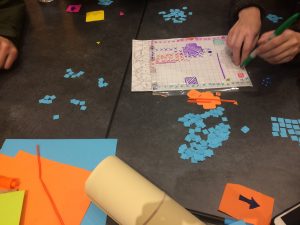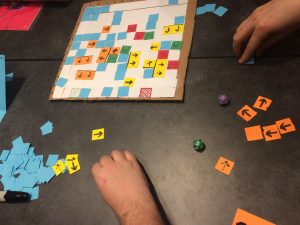 I just got back from MAGFest and it was truly awesome as always! I’m working on another post about showing my game Piroot in the Indie Showcase, but I wanted to first talk about my experience running MAGJam, a 2 hour table top game jam at MAGFest.
I just got back from MAGFest and it was truly awesome as always! I’m working on another post about showing my game Piroot in the Indie Showcase, but I wanted to first talk about my experience running MAGJam, a 2 hour table top game jam at MAGFest.
This year we had over 100 people show up, split into 20 teams. It was an amazing experience, thanks to some talented volunteers and a fantastic group of participants. If you are planning a tabletop jam like this, feel free to steal my ideas and make them better.
Panel Descriptions
The first step in setting up a panel is submitting the panel names and descriptions that will appear on the official MAGFest schedule. I decided to split it into 2 panels, first is the 2 hour game jam which is followed by a 1 hour open playtest. This is my 3rd year organizing MAGJam and I’ve used the same names and descriptions every year. These were the panel descriptions…
Tabletop Game Jam
We challenge you to build a fully playable tabletop game in only 2 hours for this year�s MAGJam. If you�ve never made a game before this is the perfect time to start, and it�s great practice for pros. Come alone or in a group, we will set you up with a team. No computers are needed and supplies will be provided, just come ready to jam! Some experienced game jam gurus will be available to help lend their advice. After the jam there will be a one hour playtest to share your games.
Tabletop Game Jam Playtest
Do you love tabletop games? Come play some new games that were just created in our tabletop game jam. We don�t know what kind of games to expect but fun is guaranteed. So even if you didn�t participate in the jam you are welcome to help playtest and share your feedback!
How It Went

The jam was scheduled to start at 3:00 on Saturday, I got to the room about 15 minutes early. A few volunteers, Taro, Bobby, and Ocean were also there and we discussed the plan. We conferred to pick the themes “Sharing” and “Snow”. I chose sharing to help encourage teams to add mechanics that get players interacting with each other, something beginners often neglect. Sharing is kind of a broad theme so we added a secondary theme “snow” to help flesh it out. In retrospect maybe “cold” would have been a more versatile choice.
The room was super nice, though it was packed and some people turned away because almost every seat was full. This year we even had tables which were a big help for the participants to have a work surface, but there wasn’t enough space for everyone. Some teams sat on the floor, the carpets in the Gaylord are super soft and it makes everywhere feel oddly comfortable.
I created a short slide deck in google slides to run participants through the rules. We began with a quick poll… “Who’s made a game before?” “Who’s done a game jam before?” and “Who’s been to MAGJam before?” I didn’t have time to count but it seemed like maybe 1/3 of people had made a game before, and a decent portion of those had been to previous MAGJams.
I quickly ran through the slides in only a couple minutes and split everyone into teams. This year I walked around the room and counted out groups of 4-5 people, giving each team a number. When that was done I announced the theme and started the timer. We officially started the game jam about 5 minutes after the hour.
Immediately everyone made a mad dash for supplies. I brought as much as I could in my checked luggage such as paper, index cards, magic markers, crayons, several pairs of scissors, tape, but it’s hard to have enough stuff for 20 teams. Working within tight constraints can inspire creativity, but some participants complained about the lack of sufficient supplies. At one point I had to make a quick run down 2 floors to get a roll of duct tape from my MIVS booth. In stroke of luck a PBS Kids game jam had gone on previously and they left us their extra supplies.
 During the game jam we had some experienced volunteers, or as we call them “game jam gurus”, walk around and advice the teams on their games. This helps teams stay focused and is way to bounce some ideas off someone outside their team. I announced a reminder over the mic every 30 minutes with accompanying slide. We instructed the teams to try to fit their game, rules and everything needed to play it, inside a ziplock freezer bag. This makes it easier to keep games separate for play testing later. My favorite part was watching the finished games roll in after the game jam was over, each one had some imaginative and cool elements.
During the game jam we had some experienced volunteers, or as we call them “game jam gurus”, walk around and advice the teams on their games. This helps teams stay focused and is way to bounce some ideas off someone outside their team. I announced a reminder over the mic every 30 minutes with accompanying slide. We instructed the teams to try to fit their game, rules and everything needed to play it, inside a ziplock freezer bag. This makes it easier to keep games separate for play testing later. My favorite part was watching the finished games roll in after the game jam was over, each one had some imaginative and cool elements.

In previous years I didn’t do anything to catalog the games that were created. This year I wanted to improve that, so I took a picture of each game and tweeted out a photo of each game when I got back from MAGFest on Sunday night. Now we have an easily searchable record of all the games that were made, and way for participants to reconnect. I would have liked to tweet out during the play test but this year I was too busy helping out.
 After the jam, there was a one hour block for play testing in the same room. It seemed like most of the participants stayed, and some more people showed up who weren’t in the game jam. I helped organize by grouping people up as they came in. Towards the end of the time I could see that people were still enjoying themselves so I negotiated and extra 30 minutes for them to wrap it up.
After the jam, there was a one hour block for play testing in the same room. It seemed like most of the participants stayed, and some more people showed up who weren’t in the game jam. I helped organize by grouping people up as they came in. Towards the end of the time I could see that people were still enjoying themselves so I negotiated and extra 30 minutes for them to wrap it up.
Plan For Next Year
 MAGJam is a big enough success that I’m going to talk with the staff about getting some money to buy supplies. This year I spent over $50 and we needed way more stuff. Maybe we could better coordinate with the other game jams going on to pool resources. Ideally it would be possible to store game jam supplies with the other MAGFest stuff so it could be easily reused each year. I’m also going to try harder to get more volunteers to help out, it’s a lot of people to wrangle.
MAGJam is a big enough success that I’m going to talk with the staff about getting some money to buy supplies. This year I spent over $50 and we needed way more stuff. Maybe we could better coordinate with the other game jams going on to pool resources. Ideally it would be possible to store game jam supplies with the other MAGFest stuff so it could be easily reused each year. I’m also going to try harder to get more volunteers to help out, it’s a lot of people to wrangle.
I want to improve the submission process. Having each team put their game in a large ziplock bag worked well, but it was hard to find out anything about the game without opening it. To help formalize things, maybe each team could display their game info like this…
- Team Name & Number
- Game Name
- One Sentence Game Description
- Player Count
- Expected Play Time
This would help keep track of the games and could be included in the tweet. Also it will help group up play testers and let them know how much of a time commitment they are in for. I’d like to announce the team name, game name and description of each game over the microphone as they come in and maybe delegate someone else take a photo and tweet them out.
This year was awesome, next year is going to be even better. Thank you again to all the volunteers and participants! I hope you all go on to make many more amazing games.







Pingback: 2019 – Year In Review – Adventures in Tiny Coding | Killed By A Pixel